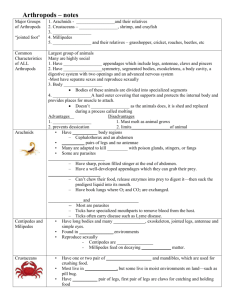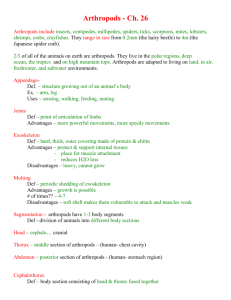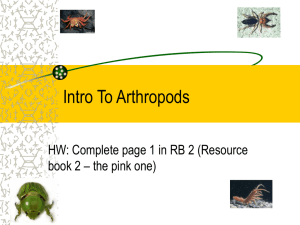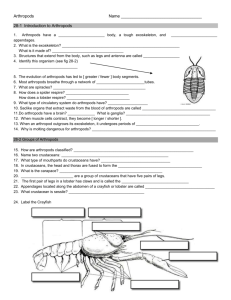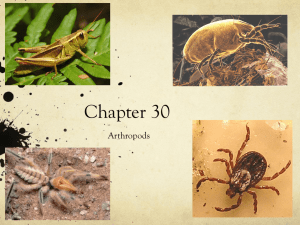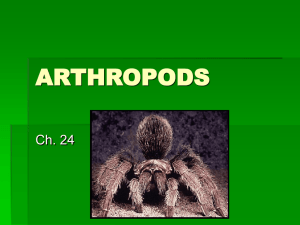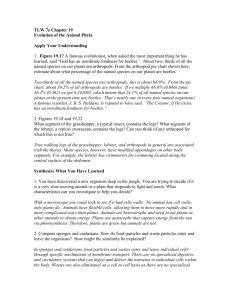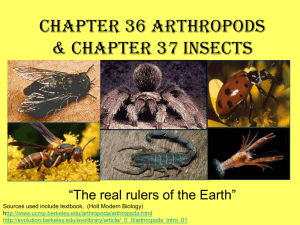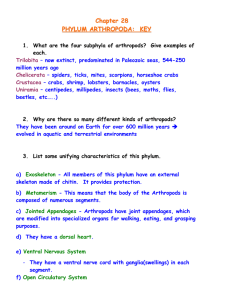Biology
advertisement
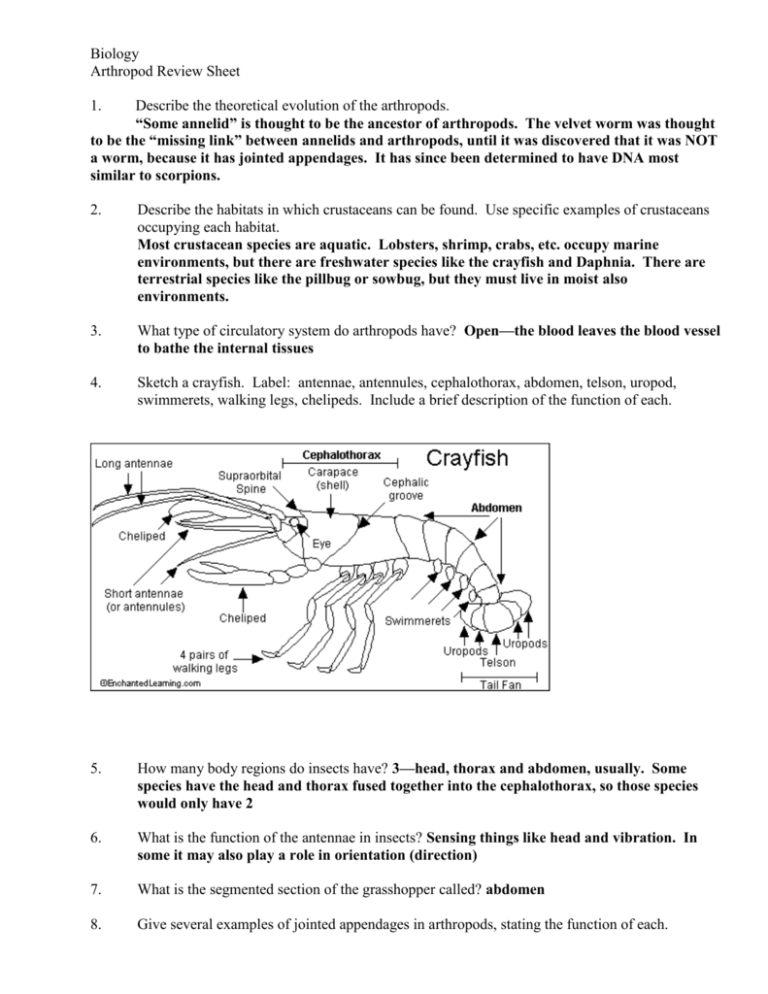
Biology Arthropod Review Sheet 1. Describe the theoretical evolution of the arthropods. “Some annelid” is thought to be the ancestor of arthropods. The velvet worm was thought to be the “missing link” between annelids and arthropods, until it was discovered that it was NOT a worm, because it has jointed appendages. It has since been determined to have DNA most similar to scorpions. 2. Describe the habitats in which crustaceans can be found. Use specific examples of crustaceans occupying each habitat. Most crustacean species are aquatic. Lobsters, shrimp, crabs, etc. occupy marine environments, but there are freshwater species like the crayfish and Daphnia. There are terrestrial species like the pillbug or sowbug, but they must live in moist also environments. 3. What type of circulatory system do arthropods have? Open—the blood leaves the blood vessel to bathe the internal tissues 4. Sketch a crayfish. Label: antennae, antennules, cephalothorax, abdomen, telson, uropod, swimmerets, walking legs, chelipeds. Include a brief description of the function of each. 5. How many body regions do insects have? 3—head, thorax and abdomen, usually. Some species have the head and thorax fused together into the cephalothorax, so those species would only have 2 6. What is the function of the antennae in insects? Sensing things like head and vibration. In some it may also play a role in orientation (direction) 7. What is the segmented section of the grasshopper called? abdomen 8. Give several examples of jointed appendages in arthropods, stating the function of each. Legs—for support and movement Some are modified into “claws” (crayfish) Chelicerae—pinching mouthparts; may be modified into fangs (spiders) or pincers (scorpion) Mandibles—chewing mouthparts in the mandibulates 9. Honeybees have specific behaviors which help them to locate food sources, and specific jobs within the hive. How do they come by these behaviors? Behavior is genetically determined 10. How are members of the subphylum Uniramia different from the other arthropods? They have chewing mouthparts and are called mandibulates. They have antennae and unbranched appendages 11. Name the first animals to evolve wings. insects 12. Sketch a spiracle/trachea system and label each part. Spiracle Trachea 13. Explain the difference between complete and incomplete metamorphosis. Complete metamorphosis is evident when there is a distinct difference between the larval and adult forms, such as in the butterfly. The caterpillar is the larva and looks wormlike, while the adult is winged with a body of 3 regions. Incomplete metamorphosis is evident when the juvenile form of the organism is simply a smaller version of the adult, such as the grasshopper. Grasshoppers look the same all their lives. 14. Where are the swimmerets of a lobster located? On the abdomen 15. What are the main distinguishing features of insects? 3 body regions, 3 pairs of legs attached to thorax (no appendages on the abdomen), usually 2 pairs of wings 16. How are crayfish similar to spiders? They share the arthropod features of segmentation, have paired, jointed appendages, a flexible exoskeleton and are bilaterally symmetric coelomates. Other than that, they are quite different, having a different number and location of appendages, branched vs. unbranched, etc. 17. Differentiate between centipedes and millipedes. The class chilopoda has one pair of legs per csegment (centipedes), are venomous, and carnivorous. The class diplopoda has 2 pairs of legs per segment (millipedes) are very stinky, and are herbivores. 18. Differentiate between the excretory mechanisms of insects and crustaceans. Insects have Malpighian tubules for excretion; crustaceans have a green gland 19. How are annelids similar to arthropods? Similarities: 1. Both are segmented. 2. Both have a cerebral ganglion 3. Both have a mouth at one end and an anus at the other. 4. They are on the same evolutionary line 5. They have similar larvae Differences: 1. Annelids do not have jointed appendages, while Arthropods do 2. Arthropods have more complex senses (eyes, for example) 3. Arthropods breathe by means of gills, while Annelids use their skin 4. Annelids have several simple hearts (like the earthworm has 5), while Arthropods have one heart. 5. Arthropods can grow only by molting because of their exoskeleton, which is not found in Annelids. 20. Why have insects become so successful? Through evolution and adaptation to hostile changes in the Earth’s environment


